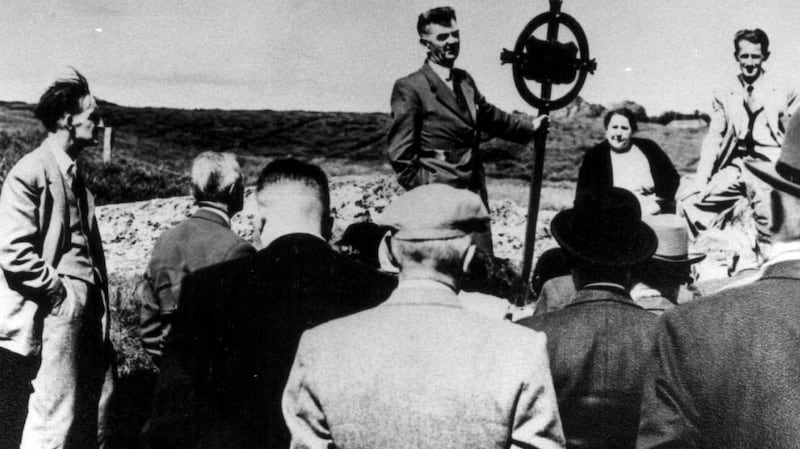What was the purpose of Brian Stanley’s tweet glorifying mass killings in two different eras? The message, sent at 8.33am on a Saturday, was no early-hours slip into sentimentalism.
That kind of tweet requires a very particular mindset. Who was he thinking of addressing, galvanising or alienating at that hour?
Was it the lads of the old brigade? Or middle-aged boyos handy with an Up the ‘Ra slogan? Or was it for the young who tread the line between shrugging off the party’s greatest hits , as regularly resurrected by party members, and then complaining that others weaponise them to shut down young Sinn Féin voices?
A 32-year-old SF ard comhairle member from Co Leitrim enjoyed the celebration in Stanley’s tweet. “He acknowledged successful IRA operations that are matter of historic record,” tweeted Seadhna Logan.

“Both were militarily very effective and highly efficient examples of Republican guerrilla ingenuity. For many like me, the role of the provos was every bit as important as the lads of Kilmichael.”
'Constantly referring to the IRA and the past to try close down debate on the issues is pointless. Using the IRA as a criticism of young Shinners is daft'
For the party’s health spokesman, David Cullinane, it was just a matter of perspective: “It is fair to say that there will never be an agreed narrative on the events of the past.”
It’s true. So let’s look at what is meant by “the past”.
Back in November, many immersed themselves in the Netflix series The Crown, specifically the episode featuring the 1979 Mountbatten murders, whose victims included 14- and 15-year-old boys and an old woman of 82. Attempting to harness the atrocity as a lesson, Fianna Fáil councillor Deirdre Conroy addressed a tweet to the “young people of Ireland” urging them “to try and learn where Sinn Féin comes from . . .”
‘IRA nonsense’
A flood of derisive replies included one from former young Green Party candidate Saoirse McHugh: “To people in their 20s, the 1970s may as well be the 1920s . . . ye have lost the plot altogether”. And here is Seadhna Logan again, making the same argument, this time back at the height of the general election campaign: “Millennials want jobs and affordable houses not to be dragged to a past they have not lived. But the IRA nonsense is irrelevant to them. I was 10 yrs of age when the GFA was signed, I always find it hilarious for political opponents to try use the RA . . . What relevance does the IRA have to young voters, absolutely none. The data showed people voted on policy platforms. Constantly referring to the IRA and the past to try close down debate on the issues is pointless. Using the IRA as a criticism of young Shinners is daft.”
The War of Independence is not really in 'the past' if the fury over the proposed Royal Irish Constabulary commemoration is any guide
But youth is no shield as any young person who has lost a loved one knows well. Seadhna Logan is around the same age as my daughters who vividly remember the morning I pulled the car over on the Naas dual carriageway and turned up the radio so they could hear the announcement of the first IRA ceasefire. This was a moment of history when scenes from terrible assignments in the North came flooding back. They remain a long way from “the past”.

Who decides where the delineation between “the past” and the present resides? Pat Finucane was brutally murdered 30 years ago so why do so many feel sucker-punched by this week’s British government announcement that it will not investigate the collusion around his death? Why does the sight of his determined, battling widow still move us 30 years on? Why are the hunger strikers still venerated after 40 years? Why is the peace process still considered so fragile? Is it that “the past” or selected parts of “the past” are supposed to be only meaningful for some?
Murder of innocents
The answer is that the past never goes away. It is in our DNA, our folk memory, our mindset. It’s what still sends men out to acquire guns and murder innocents like Lyra McKee. It’s why careless tweets from influential people truly matter.
The War of Independence is not really in “the past” if the fury over the proposed Royal Irish Constabulary commemoration is any guide. But does anyone seriously suggest there were comparable mandates for the War of Independence and Warrenpoint? In summer 1978, barely one-fifth of people in the Republic expressed some level of support for the IRA according to an Economic and Social Research Institute opinion poll. The other clear distinction is that some of those involved at Warrenpoint are still alive – as, more importantly, are mutilated survivors and close relatives of the dead.
How much of the real and perceived injustice was worth the life of one 15-year-old boy?
Apart from the 22-body haul from Warrenpoint and Mullaghmore, 40 more people died at the hands of the IRA in 1979. They included 32-year-old Eamon Ryan shot dead during a bank robbery in Tramore, Co Waterford, two 16-year-old boys, and the British ambassador to the Netherlands, killed along with his 19-year-old valet.
The other side clocked up eight separate killings of young Catholic men. In February that year 11 loyalists known as the “Shankill butchers” were sentenced to life for 112 offences including 19 murders after five years roaming unfettered through Belfast by night hunting for Catholics to torture and murder with butcher knives and axes.
How much of the real and perceived injustice was worth the life of one 15-year-old boy? How many of those victims and their small, modest lives can be consigned to “the past” because “young Shinners” don’t feel it? How many deaths can be written off as the fault of “slow learners”?
We know how Séamus Mallon and John Hume would have answered.











